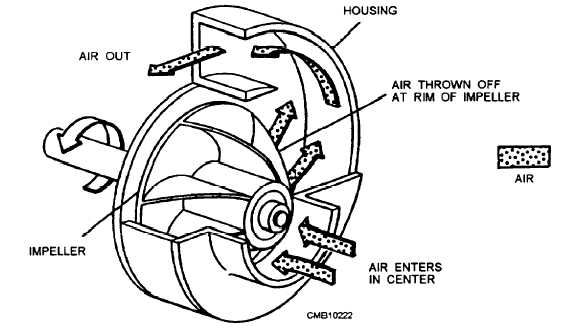1. Centrifugal supercharger (fig. 5-39). The centrifugal supercharger has an impeller equipped with curved vanes. As the engine drives the impeller, it draws air into its center and throws it off at its rim. The air then is pushed along the inside of the circular housing. The diameter of the housing gradually increases to the outlet where the air is pushed out.
2. Rotor (Rootes) supercharger (fig. 5-40). The Rootes supercharger is of the positive displacement type and consists of two rotors inside a housing. As the engine drives the rotors, air is trapped between them and the housing. Air is then carried to the outlet where it is discharged. The rotors and the housing in this type of supercharger must maintain tight clearances and therefore are sensitive to dirt.
3. Vane-type supercharger (fig. 5-41). The vane- type supercharger has an integral steel rotor and shaft, one end supported in the pump flange and the other end in the cover, and revolves in the body, the bore of which is eccentric to the rotor. Two sliding vanes are placed 180 degrees apart in slots in the rotor and are pressed against the body bore by springs in the slots. When the shaft rotates, the vanes pick up a charge of air at the inlet port, and it is carried around the body to the outlet where the air is discharged. Pressure is produced by the wedging action of the air, as it is forced toward the outlet port by the vane.

Figure 5-39. - Centrifugal supercharger.
The term supercharger generally refers to a blower driven by a belt, chain, or gears. Superchargers are used on large diesel and racing engines.

Figure 5-40. - Rootes supercharger.
Continue Reading